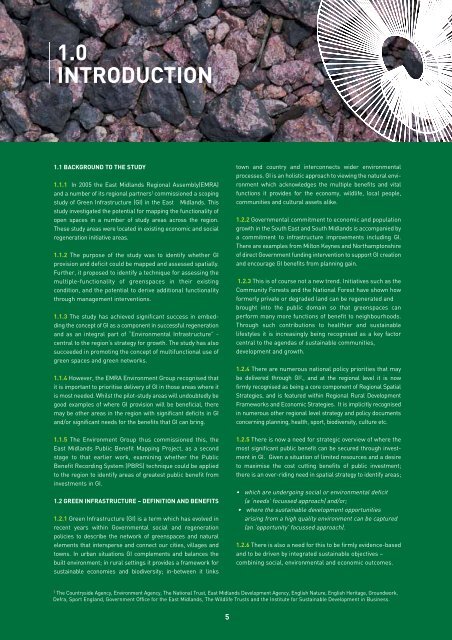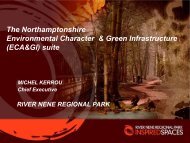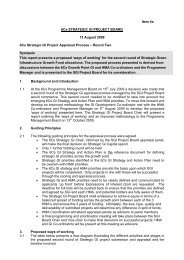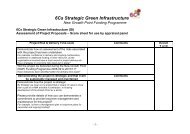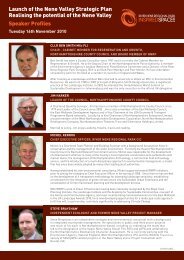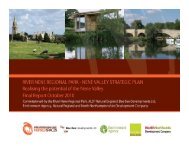Green Infrastructure for the East Midlands - River Nene Regional Park
Green Infrastructure for the East Midlands - River Nene Regional Park
Green Infrastructure for the East Midlands - River Nene Regional Park
You also want an ePaper? Increase the reach of your titles
YUMPU automatically turns print PDFs into web optimized ePapers that Google loves.
1.0<br />
INTRODUCTION<br />
1.1 BACKGROUND TO THE STUDY<br />
1.1.1 In 2005 <strong>the</strong> <strong>East</strong> <strong>Midlands</strong> <strong>Regional</strong> Assembly(EMRA)<br />
and a number of its regional partners 1 commissioned a scoping<br />
study of <strong>Green</strong> <strong>Infrastructure</strong> (GI) in <strong>the</strong> <strong>East</strong> <strong>Midlands</strong>. This<br />
study investigated <strong>the</strong> potential <strong>for</strong> mapping <strong>the</strong> functionality of<br />
open spaces in a number of study areas across <strong>the</strong> region.<br />
These study areas were located in existing economic and social<br />
regeneration initiative areas.<br />
1.1.2 The purpose of <strong>the</strong> study was to identify whe<strong>the</strong>r GI<br />
provision and deficit could be mapped and assessed spatially.<br />
Fur<strong>the</strong>r, it proposed to identify a technique <strong>for</strong> assessing <strong>the</strong><br />
multiple-functionality of greenspaces in <strong>the</strong>ir existing<br />
condition, and <strong>the</strong> potential to derive additional functionality<br />
through management interventions.<br />
1.1.3 The study has achieved significant success in embedding<br />
<strong>the</strong> concept of GI as a component in successful regeneration<br />
and as an integral part of “Environmental <strong>Infrastructure</strong>” -<br />
central to <strong>the</strong> region’s strategy <strong>for</strong> growth. The study has also<br />
succeeded in promoting <strong>the</strong> concept of multifunctional use of<br />
green spaces and green networks.<br />
1.1.4 However, <strong>the</strong> EMRA Environment Group recognised that<br />
it is important to prioritise delivery of GI in those areas where it<br />
is most needed. Whilst <strong>the</strong> pilot-study areas will undoubtedly be<br />
good examples of where GI provision will be beneficial, <strong>the</strong>re<br />
may be o<strong>the</strong>r areas in <strong>the</strong> region with significant deficits in GI<br />
and/or significant needs <strong>for</strong> <strong>the</strong> benefits that GI can bring.<br />
1.1.5 The Environment Group thus commissioned this, <strong>the</strong><br />
<strong>East</strong> <strong>Midlands</strong> Public Benefit Mapping Project, as a second<br />
stage to that earlier work, examining whe<strong>the</strong>r <strong>the</strong> Public<br />
Benefit Recording System (PBRS) technique could be applied<br />
to <strong>the</strong> region to identify areas of greatest public benefit from<br />
investments in GI.<br />
1.2 GREEN INFRASTRUCTURE – DEFINITION AND BENEFITS<br />
1.2.1 <strong>Green</strong> <strong>Infrastructure</strong> (GI) is a term which has evolved in<br />
recent years within Governmental social and regeneration<br />
policies to describe <strong>the</strong> network of greenspaces and natural<br />
elements that intersperse and connect our cities, villages and<br />
towns. In urban situations GI complements and balances <strong>the</strong><br />
built environment; in rural settings it provides a framework <strong>for</strong><br />
sustainable economies and biodiversity; in-between it links<br />
town and country and interconnects wider environmental<br />
processes. GI is an holistic approach to viewing <strong>the</strong> natural environment<br />
which acknowledges <strong>the</strong> multiple benefits and vital<br />
functions it provides <strong>for</strong> <strong>the</strong> economy, wildlife, local people,<br />
communities and cultural assets alike.<br />
1.2.2 Governmental commitment to economic and population<br />
growth in <strong>the</strong> South <strong>East</strong> and South <strong>Midlands</strong> is accompanied by<br />
a commitment to infrastructure improvements including GI.<br />
There are examples from Milton Keynes and Northamptonshire<br />
of direct Government funding intervention to support GI creation<br />
and encourage GI benefits from planning gain.<br />
1.2.3 This is of course not a new trend. Initiatives such as <strong>the</strong><br />
Community Forests and <strong>the</strong> National Forest have shown how<br />
<strong>for</strong>merly private or degraded land can be regenerated and<br />
brought into <strong>the</strong> public domain so that greenspaces can<br />
per<strong>for</strong>m many more functions of benefit to neighbourhoods.<br />
Through such contributions to healthier and sustainable<br />
lifestyles it is increasingly being recognised as a key factor<br />
central to <strong>the</strong> agendas of sustainable communities,<br />
development and growth.<br />
1.2.4 There are numerous national policy priorities that may<br />
be delivered through GI 2 ., and at <strong>the</strong> regional level it is now<br />
firmly recognised as being a core component of <strong>Regional</strong> Spatial<br />
Strategies, and is featured within <strong>Regional</strong> Rural Development<br />
Frameworks and Economic Strategies. It is implicitly recognised<br />
in numerous o<strong>the</strong>r regional level strategy and policy documents<br />
concerning planning, health, sport, biodiversity, culture etc.<br />
1.2.5 There is now a need <strong>for</strong> strategic overview of where <strong>the</strong><br />
most significant public benefit can be secured through investment<br />
in GI. Given a situation of limited resources and a desire<br />
to maximise <strong>the</strong> cost cutting benefits of public investment;<br />
<strong>the</strong>re is an over-riding need in spatial strategy to identify areas;<br />
• which are undergoing social or environmental deficit<br />
(a ‘needs’ focussed approach) and/or;<br />
• where <strong>the</strong> sustainable development opportunities<br />
arising from a high quality environment can be captured<br />
(an ‘opportunity’ focussed approach).<br />
1.2.6 There is also a need <strong>for</strong> this to be firmly evidence-based<br />
and to be driven by integrated sustainable objectives –<br />
combining social, environmental and economic outcomes.<br />
1 The Countryside Agency, Environment Agency, The National Trust, <strong>East</strong> <strong>Midlands</strong> Development Agency, English Nature, English Heritage, Groundwork,<br />
Defra, Sport England, Government Office <strong>for</strong> <strong>the</strong> <strong>East</strong> <strong>Midlands</strong>, The Wildlife Trusts and <strong>the</strong> Institute <strong>for</strong> Sustainable Development in Business.<br />
5


